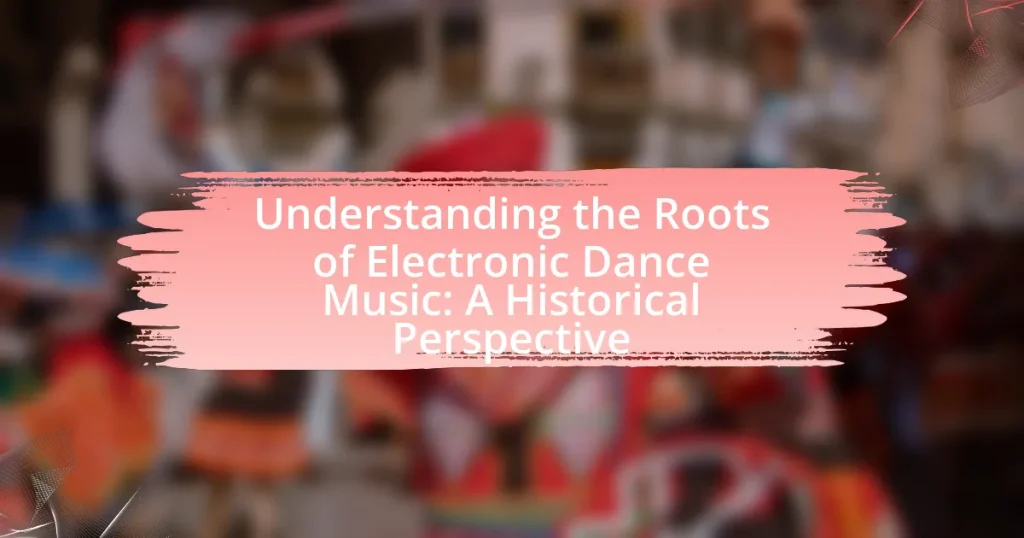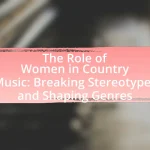The article “Understanding the Roots of Electronic Dance Music: A Historical Perspective” explores the origins and evolution of Electronic Dance Music (EDM) from the late 1970s to the present. It examines the influence of early musical movements such as disco, funk, and hip-hop, highlighting key artists and technological advancements that shaped the genre. The article discusses the role of underground club culture, the impact of globalization and the internet on music distribution, and the emergence of various sub-genres within EDM. Additionally, it addresses contemporary trends, production techniques, and best practices for engaging with EDM culture, providing a comprehensive overview of the genre’s historical context and its ongoing evolution.
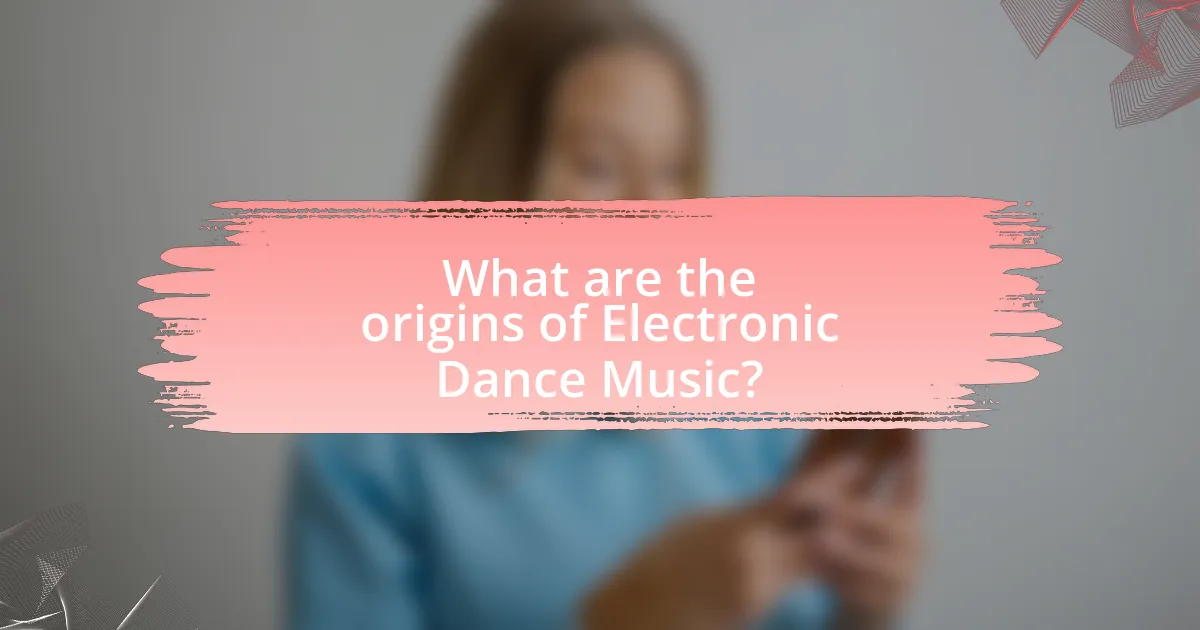
What are the origins of Electronic Dance Music?
The origins of Electronic Dance Music (EDM) can be traced back to the late 1970s and early 1980s, primarily emerging from the fusion of disco, funk, and electronic music. Pioneering artists like Kraftwerk and Giorgio Moroder utilized synthesizers and drum machines, laying the groundwork for the genre. The development of house music in Chicago and techno in Detroit during the 1980s further solidified EDM’s foundation, with clubs and raves becoming central to its culture. These movements were characterized by the use of electronic instruments and a focus on rhythm, which attracted a diverse audience and led to the global proliferation of EDM in subsequent decades.
How did early musical movements influence Electronic Dance Music?
Early musical movements significantly influenced Electronic Dance Music (EDM) by introducing innovative sounds, rhythms, and cultural practices. Genres such as disco, funk, and hip-hop laid the groundwork for EDM’s development, particularly through their emphasis on beat-driven music and the use of synthesizers. For instance, disco’s four-on-the-floor beat became a staple in EDM, while funk’s syncopated rhythms and hip-hop’s sampling techniques directly contributed to the genre’s evolution. Additionally, the emergence of electronic instruments in the late 20th century, such as the Roland TR-808 drum machine, further shaped the sound of EDM, allowing for new creative possibilities. These early movements not only provided the musical foundation but also fostered a culture of dance and community that remains central to EDM today.
What role did disco play in the development of Electronic Dance Music?
Disco played a crucial role in the development of Electronic Dance Music (EDM) by establishing foundational elements such as the four-on-the-floor beat, syncopated basslines, and the use of synthesizers. These characteristics became integral to EDM genres that emerged in the late 1970s and 1980s, including house and techno. The disco scene also popularized DJ culture, where mixing and remixing tracks became essential, influencing how electronic music was produced and consumed. Additionally, the rise of disco clubs and dance floors created a social environment that celebrated dance music, paving the way for the acceptance and growth of electronic genres.
How did the emergence of synthesizers shape the sound of Electronic Dance Music?
The emergence of synthesizers fundamentally transformed the sound of Electronic Dance Music (EDM) by introducing new textures, timbres, and production techniques. Synthesizers allowed artists to create a wide range of sounds that were previously unattainable with traditional instruments, enabling the development of unique genres within EDM such as techno, house, and trance. The introduction of iconic synthesizers like the Moog and Roland TB-303 in the 1970s and 1980s provided musicians with the ability to manipulate sound through modulation, sequencing, and layering, which became essential elements in EDM production. This technological advancement not only expanded the sonic palette available to producers but also influenced the rhythmic and melodic structures characteristic of EDM, leading to its widespread popularity in clubs and festivals worldwide.
What cultural factors contributed to the rise of Electronic Dance Music?
The rise of Electronic Dance Music (EDM) was significantly influenced by cultural factors such as the evolution of technology, the emergence of rave culture, and the globalization of music. Technological advancements in music production, including synthesizers and digital audio workstations, allowed artists to create new sounds and genres, which attracted a diverse audience. The rave culture of the late 1980s and early 1990s, characterized by underground parties and a sense of community, fostered a unique environment for EDM to flourish. Additionally, the globalization of music through the internet and social media enabled the rapid spread of EDM across different cultures, leading to its mainstream acceptance and integration into popular music. These factors collectively contributed to the widespread popularity and evolution of Electronic Dance Music.
How did the underground club scene impact the popularity of Electronic Dance Music?
The underground club scene significantly boosted the popularity of Electronic Dance Music (EDM) by providing a dedicated space for its development and exposure. Clubs like The Warehouse in Chicago and The Paradise Garage in New York became pivotal venues where DJs could experiment with new sounds and styles, fostering a community around EDM. This grassroots movement led to the emergence of iconic subgenres, such as house and techno, which gained traction through word-of-mouth and underground raves. The scene’s emphasis on inclusivity and freedom of expression attracted diverse audiences, further amplifying EDM’s reach. By the late 1980s and early 1990s, the underground club culture had laid the foundation for mainstream acceptance, as artists and tracks that originated in these venues began to chart on popular music lists, solidifying EDM’s place in the global music landscape.
What influence did technology have on the accessibility of Electronic Dance Music?
Technology significantly enhanced the accessibility of Electronic Dance Music (EDM) by enabling widespread distribution and production capabilities. The advent of digital audio workstations (DAWs) like Ableton Live and FL Studio allowed aspiring producers to create high-quality music from home, reducing the need for expensive studio time. Additionally, the rise of the internet and streaming platforms such as SoundCloud and Spotify facilitated the sharing and discovery of EDM tracks globally, allowing artists to reach audiences without traditional record label support. According to a 2020 report by the International Federation of the Phonographic Industry, streaming accounted for 62% of global recorded music revenue, underscoring the pivotal role of technology in democratizing music access.
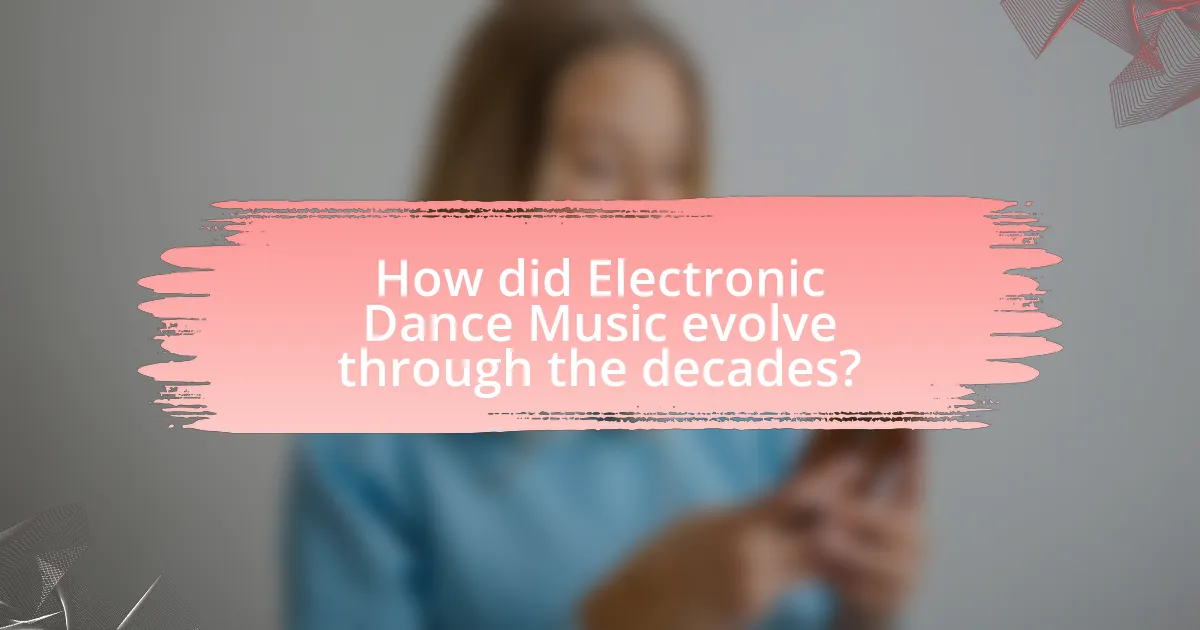
How did Electronic Dance Music evolve through the decades?
Electronic Dance Music (EDM) evolved significantly from the 1970s to the 2020s, transitioning through various styles and cultural influences. In the 1970s, the genre emerged with disco and early electronic sounds, exemplified by artists like Kraftwerk, who utilized synthesizers and drum machines. The 1980s saw the rise of house music in Chicago and techno in Detroit, characterized by repetitive beats and synthesized melodies, with influential tracks like “Move Your Body” by Marshall Jefferson and “Strings of Life” by Derrick May.
The 1990s introduced rave culture and subgenres such as trance and drum and bass, with iconic events like the Love Parade in Berlin and tracks like “Children” by Robert Miles gaining mainstream attention. In the 2000s, EDM began to infiltrate pop music, with artists like David Guetta collaborating with mainstream singers, leading to a broader acceptance of the genre. The 2010s marked the peak of EDM’s popularity, with festivals like Tomorrowland and Ultra Music Festival drawing massive crowds, and artists like Calvin Harris and Skrillex dominating the charts.
By the 2020s, EDM continued to diversify, incorporating elements from hip-hop, pop, and even classical music, while also embracing digital platforms for distribution and promotion. This evolution reflects the genre’s adaptability and its ability to resonate with changing cultural landscapes.
What were the key milestones in the history of Electronic Dance Music?
The key milestones in the history of Electronic Dance Music (EDM) include the emergence of disco in the 1970s, the development of house music in Chicago during the early 1980s, and the rise of techno in Detroit around the same time. Disco laid the groundwork for electronic beats and DJ culture, while house music, characterized by its repetitive 4/4 beats and synthesized sounds, gained popularity in clubs. Techno, with its futuristic soundscapes, further expanded the genre’s boundaries. The 1990s saw the explosion of rave culture and the mainstream acceptance of EDM, highlighted by events like the Love Parade in Berlin. The 2000s introduced subgenres such as trance and dubstep, leading to global festivals and the rise of prominent DJs like Tiësto and Skrillex. These milestones collectively shaped EDM into a dominant force in contemporary music.
How did the 1980s and 1990s shape the genres within Electronic Dance Music?
The 1980s and 1990s significantly shaped the genres within Electronic Dance Music (EDM) by introducing foundational styles and technological advancements. In the 1980s, the emergence of genres like house and techno in cities such as Chicago and Detroit established the core elements of EDM, characterized by repetitive beats and synthesized sounds. The use of drum machines, synthesizers, and samplers became prevalent, allowing artists to create new sounds and structures that defined these genres.
In the 1990s, the proliferation of rave culture and the rise of subgenres like trance, drum and bass, and jungle further diversified EDM. The introduction of digital audio workstations and software for music production made it easier for producers to experiment and innovate. Major events like the Love Parade in Berlin and the emergence of record labels such as Warp and Ninja Tune played crucial roles in popularizing these genres globally.
These decades laid the groundwork for the EDM explosion in the 2000s, with the influence of 1980s and 1990s styles still evident in contemporary electronic music.
What role did festivals play in the growth of Electronic Dance Music culture?
Festivals played a crucial role in the growth of Electronic Dance Music (EDM) culture by providing a platform for artists to showcase their music and for fans to experience the genre in a communal setting. These large-scale events, such as Tomorrowland and Ultra Music Festival, attracted thousands of attendees, fostering a sense of community and shared experience among fans. The rise of festivals in the 1990s and 2000s coincided with the mainstream acceptance of EDM, as they offered immersive environments that highlighted the genre’s vibrant culture, including visual art, fashion, and interactive experiences. Additionally, the marketing and promotion of these festivals significantly contributed to the global reach of EDM, with many events being live-streamed and shared on social media, further amplifying their impact.
How did globalization affect the spread of Electronic Dance Music?
Globalization significantly accelerated the spread of Electronic Dance Music (EDM) by facilitating cross-cultural exchanges and enhancing access to diverse musical influences. The rise of the internet and digital platforms allowed artists from different countries to share their work globally, leading to the emergence of various EDM subgenres influenced by regional sounds. For instance, the popularity of house music in Chicago during the 1980s spread to Europe, where it evolved into techno and trance, further disseminated through international music festivals and online streaming services. This interconnectedness has resulted in a global EDM culture, with artists collaborating across borders and audiences engaging with music from different parts of the world, exemplified by events like Tomorrowland and Ultra Music Festival, which attract attendees from multiple countries.
What impact did the internet have on the distribution of Electronic Dance Music?
The internet revolutionized the distribution of Electronic Dance Music (EDM) by enabling artists to share their music globally without traditional barriers. This shift allowed independent producers to reach wider audiences through platforms like SoundCloud, Bandcamp, and social media, facilitating the rapid spread of EDM genres and subcultures. For instance, the rise of digital downloads and streaming services has led to a significant increase in the accessibility of EDM tracks, with Spotify reporting over 30 million EDM playlists created by users. This democratization of music distribution has transformed the EDM landscape, allowing for diverse sounds and styles to emerge and thrive.
How did international artists contribute to the genre’s diversity?
International artists significantly contributed to the diversity of electronic dance music (EDM) by introducing unique cultural influences, sounds, and styles from their respective regions. For instance, artists from Africa incorporated traditional rhythms and instruments, while those from Europe brought in elements of techno and house, leading to a fusion of genres. This cross-pollination is evident in the global popularity of sub-genres like Afro-house and Euro-trance, which blend local musical traditions with electronic elements. The collaboration between artists from different countries has also resulted in innovative productions that reflect a wide array of cultural backgrounds, enhancing the overall richness of the genre.
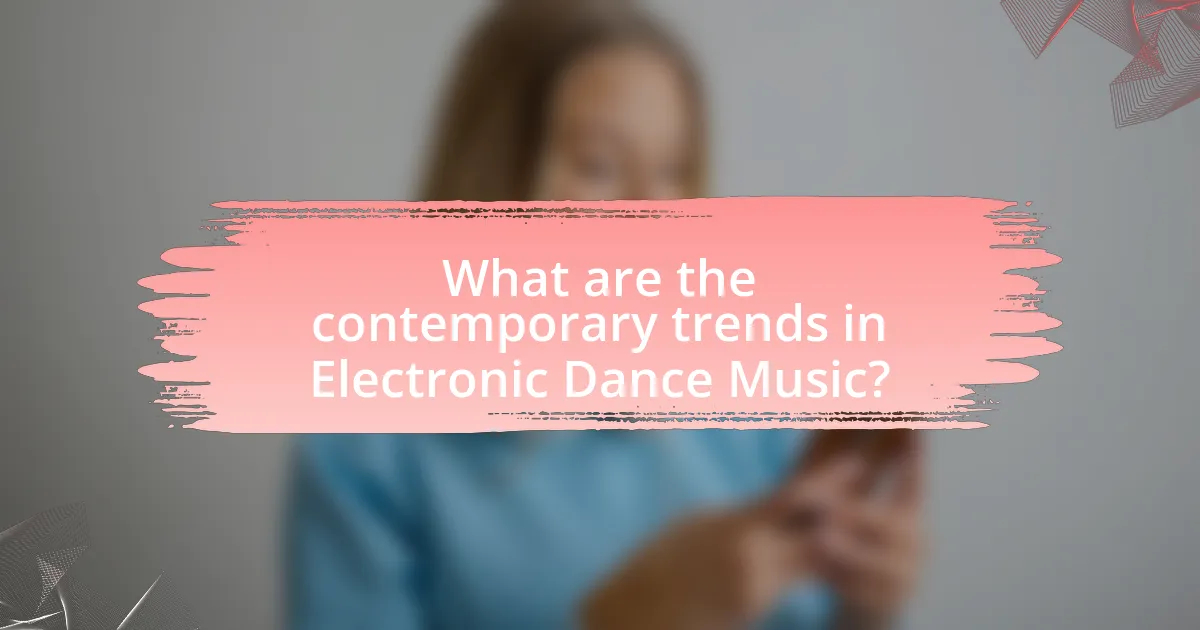
What are the contemporary trends in Electronic Dance Music?
Contemporary trends in Electronic Dance Music (EDM) include the rise of sub-genres such as future bass, melodic techno, and lo-fi house, which reflect a diversification of styles within the genre. Additionally, the integration of live instrumentation and vocal performances in DJ sets has become increasingly popular, enhancing the overall experience for audiences. Collaborations between EDM artists and mainstream pop musicians have also surged, exemplified by tracks that blend electronic elements with pop sensibilities, leading to broader appeal and chart success. Furthermore, the use of technology, such as artificial intelligence in music production and virtual reality in live performances, is shaping the future of EDM, allowing for innovative experiences and creative possibilities. These trends are supported by data indicating that the global EDM market is projected to grow significantly, reaching approximately $9 billion by 2027, highlighting the genre’s expanding influence and popularity.
How are modern technologies influencing the production of Electronic Dance Music?
Modern technologies are significantly influencing the production of Electronic Dance Music (EDM) by providing advanced tools and software that enhance creativity and efficiency. Digital Audio Workstations (DAWs) like Ableton Live and FL Studio allow producers to create, edit, and mix music with unprecedented precision and flexibility. Additionally, the availability of virtual instruments and plugins enables artists to experiment with a wide range of sounds and effects, leading to innovative musical styles. The rise of online collaboration platforms facilitates real-time cooperation among artists globally, further diversifying the EDM landscape. According to a 2021 report by the International Music Summit, over 70% of EDM producers utilize technology-driven methods in their production processes, underscoring the profound impact of modern technologies on the genre.
What software and tools are commonly used in Electronic Dance Music production today?
Commonly used software and tools in Electronic Dance Music (EDM) production today include Digital Audio Workstations (DAWs) like Ableton Live, FL Studio, and Logic Pro. These DAWs provide essential features for composing, arranging, and mixing music. Additionally, synthesizers such as Serum, Massive, and Sylenth1 are popular for sound design, while plugins like iZotope Ozone and Waves offer mastering and mixing capabilities. The prevalence of these tools is supported by their integration into the workflows of many successful EDM producers, highlighting their effectiveness in creating high-quality music.
How has social media changed the way artists promote their Electronic Dance Music?
Social media has transformed the promotion of Electronic Dance Music (EDM) by enabling artists to reach global audiences instantly and interactively. Platforms like Instagram, Facebook, and TikTok allow artists to share music, engage with fans, and create viral marketing campaigns, significantly reducing reliance on traditional media outlets. For instance, a study by the International Journal of Music Business Research found that 70% of EDM artists reported increased fan engagement through social media, leading to higher ticket sales and streaming numbers. This shift has democratized music promotion, allowing independent artists to gain visibility without major label support.
What are the current sub-genres of Electronic Dance Music?
The current sub-genres of Electronic Dance Music (EDM) include House, Techno, Trance, Dubstep, Drum and Bass, Electro, Progressive House, Future Bass, Hardstyle, and Deep House. Each sub-genre has distinct characteristics; for example, House music is known for its repetitive beats and soulful vocals, while Dubstep features heavy bass and syncopated rhythms. The diversity within EDM reflects its evolution and the influence of various musical styles, with House originating in the 1980s and Dubstep emerging in the early 2000s. This classification is supported by the ongoing popularity and distinct festival lineups that showcase these sub-genres, indicating their relevance in contemporary music culture.
How do different sub-genres appeal to various audiences within Electronic Dance Music?
Different sub-genres of Electronic Dance Music (EDM) appeal to various audiences through distinct musical characteristics, cultural contexts, and emotional resonances. For instance, house music, known for its repetitive beats and soulful vocals, attracts listeners seeking a feel-good, uplifting experience, often associated with club culture. In contrast, techno, characterized by its minimalistic and industrial sounds, appeals to audiences who appreciate a more cerebral and immersive experience, often found in underground raves.
Moreover, genres like dubstep, with its heavy bass drops and aggressive sound design, resonate with younger audiences looking for high-energy and intense experiences, while trance, known for its melodic and euphoric elements, attracts those seeking emotional and transcendent moments. According to a study by the International Journal of Music Business Research, the diversity in sub-genres allows EDM to cater to a wide range of preferences, ensuring that different audience segments find their niche within the broader EDM landscape.
What are the characteristics that define popular sub-genres today?
Popular sub-genres today are characterized by distinct musical styles, cultural influences, and technological advancements. Each sub-genre, such as house, techno, and dubstep, showcases unique tempo ranges, instrumentation, and production techniques that cater to specific audiences. For instance, house music typically features a 120-130 BPM tempo, soulful vocals, and repetitive beats, while techno is known for its driving rhythms and minimalistic soundscapes. Additionally, the rise of digital production tools has enabled artists to experiment with sound design, leading to innovative fusions and hybrid genres. This evolution reflects the dynamic nature of electronic dance music, where cultural trends and technological innovations continuously shape its landscape.
What are some best practices for engaging with Electronic Dance Music culture?
To effectively engage with Electronic Dance Music (EDM) culture, individuals should immerse themselves in the music and its history, attend live events, and connect with the community. Engaging with the music involves exploring various subgenres, understanding influential artists, and recognizing the evolution of EDM from its origins in the late 1970s and early 1980s, such as disco and techno. Attending live events, including festivals and club nights, allows for firsthand experience of the culture and fosters connections with other fans and artists. Community engagement can be enhanced by participating in online forums, social media groups, and local meetups, which facilitate discussions and sharing of experiences. These practices not only deepen appreciation for EDM but also promote a sense of belonging within the culture.
